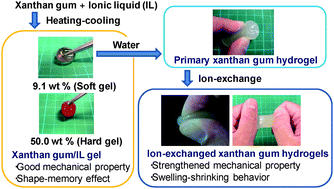Preparation and characterizations of functional ionic liquid-gel and hydrogel materials of xanthan gum
Abstract
In this paper, we describe a detailed study on preparation and characterizations of functional ionic liquid-gels and hydrogels of

* Corresponding authors
a
Graduate School of Science and Engineering, Kagoshima University, 1-21-40 Korimoto, Kagoshima, Japan
E-mail:
kadokawa@eng.kagoshima-u.ac.jp
Fax: +81 99 285 3253
Tel: +81 99 285 7743
In this paper, we describe a detailed study on preparation and characterizations of functional ionic liquid-gels and hydrogels of

 Please wait while we load your content...
Something went wrong. Try again?
Please wait while we load your content...
Something went wrong. Try again?
H. Izawa and J. Kadokawa, J. Mater. Chem., 2010, 20, 5235 DOI: 10.1039/C0JM00595A
To request permission to reproduce material from this article, please go to the Copyright Clearance Center request page.
If you are an author contributing to an RSC publication, you do not need to request permission provided correct acknowledgement is given.
If you are the author of this article, you do not need to request permission to reproduce figures and diagrams provided correct acknowledgement is given. If you want to reproduce the whole article in a third-party publication (excluding your thesis/dissertation for which permission is not required) please go to the Copyright Clearance Center request page.
Read more about how to correctly acknowledge RSC content.
 Fetching data from CrossRef.
Fetching data from CrossRef.
This may take some time to load.
Loading related content
